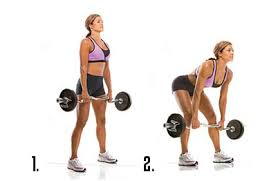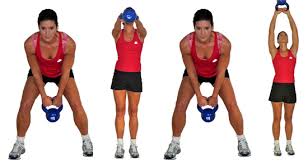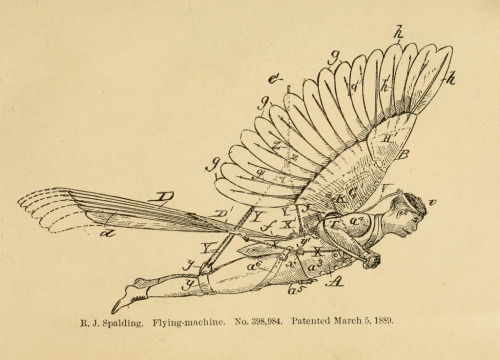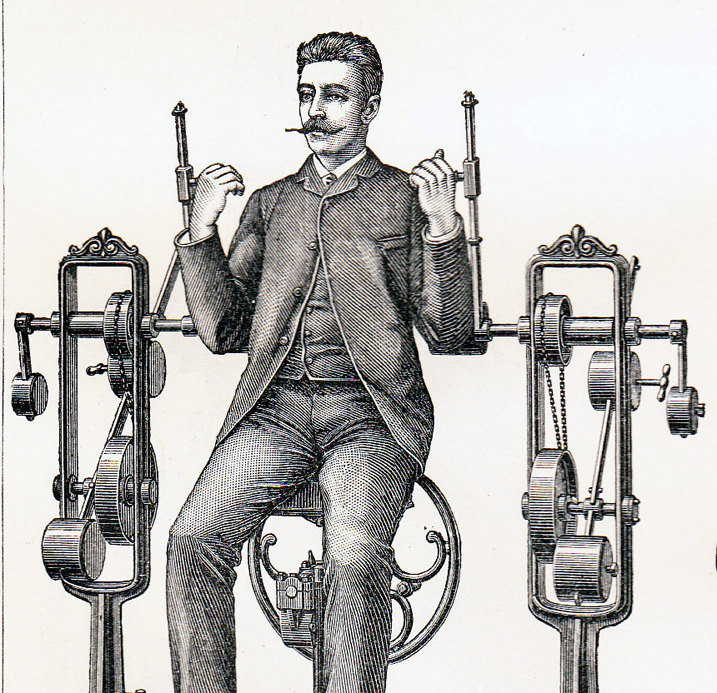This is the final addition to the exercise program. To attain peak health, it is necessary to challenge the power generation capability of the cells.
More specifically, the mitochondrial energy generating capability is challenged, and in response, they will increase both their efficiency and numbers. Optimizing this is the formula for peak health. (Of course, we assume here a healthy diet and low stress lifestyle.)
To accomplish this, we will take the two intense sessions, which at this point already have squats and deadlifts as osteoporosis prevention, and have rowing for heart rate variability. We will add, for each intense day, three or four more power exercises.
The is the 6th in the exercise series. Joint maintenance was discussed here, balance and neurogenesis here, osteoporosis prevention here. and heart rate variability here.
The various exercises about to be proposed will continue the transformation toward peak biological power. This is the final piece of our exercise program. To optimize this, we would suggest you choose from about half dozen key exercises, which we call Tier One, and execute them in a particular way. Don’t pile on weight till you master form and full range movement. Weight is important though, just do it last, after you have mastered everything else.
Whole-Body, Explosive, Concentric, Multi-Planar, Closed-Chain
This describes the principles that should be followed for all exercise, even climbing a flight of stairs or getting out of a chair. Doing exercise this way will maximize the benefit on several levels. Here is a description. This may sound a bit technical, but it isn’t rocket science. It is more of a point of view, so bear with us. This is the final part:
Whole Body means that several things are moving at once. This continues to improve neural function and coordination and stimulates growth of new nerves.
Explosive means pushing as hard and quickly as possible. This improves mitochondrial efficiency and number, which in turn slows aging and increases cellular health and strength—biological power.This one is key.
Concentric means a muscle is contracting when it is doing the work. If you curl a dumbbell, the exercise is concentric on the way up, and eccentric as you let the weight down. It’s the concentric exercise that turns on anabolism, and that’s what we want. Of course, a complete movement tends to involve both, so do the concentric part explosively, with a burst of energy, but do the eccentric part slowly. This one is important too.
Multi-planar simply means not merely working in a single plane, such as push/pull, or extension/flexion. This improves balance, coordination, and neural function.
Closed-chain means recruitment of the neurological chain; an exercise involving all the stabilizing small muscle movements. Tier One exercises, like squats and deadlifts are examples of this. Most gym machines are not.
We’ll give this sort of exercise an acronym: WECMC. To get the maximum effect from exercise, these elements need to be incorporated. This will cause the exercises to be done in a somewhat different fashion.
Tier One Exercises
These are the most efficient exercises and should be done in a WECMC fashion. The following is a description of several such exercises. Watch the videos on QuantitativeMedicine.net to see how these exercises should be done. Better, hire a trainer, at least for a session or two. In any event, start with minimal weight until you have mastered the form, and then move up slowly. Don’t rush, or you will tear a tendon or ligament, and these can take up to two years to heal. The concentric part should be explosive. The eccentric part, slow.
Squats. Squats are an ideal whole-body exercise. Go down slowly into the squat, and then explosively push up hard with your legs, the up movement is concentric because muscles are shortening while working, the exercise is multi-planar, involving a complex series of motions, and closed-chain, due to the sequence of neural-muscular activity and balance required. The explosive start and the whole body involvement are crucial elements. Form is important. Doing squats this way will also serve to prevent osteoporosis.
Deadlifts. Again, back stiff and arched back, head up (head up position make it easier to have the right form), grab the bar and get it off the ground using your legs. Then straighten the back. Never let your back hunch over. Once you are confident with this exercise, try to increase the speed of the lift. This exercise can also be done in a “Sumo” position, with your legs wide, and arms between your legs.Doing deadlifts this way will also serve to prevent osteoporosis.
right form), grab the bar and get it off the ground using your legs. Then straighten the back. Never let your back hunch over. Once you are confident with this exercise, try to increase the speed of the lift. This exercise can also be done in a “Sumo” position, with your legs wide, and arms between your legs.Doing deadlifts this way will also serve to prevent osteoporosis.
Pull-ups. If you cannot do a pull-up, use the assisted pull-up machine. Most gyms have these. Grab the bar, completely relaxed. Start the move with your back, then power yourself up.
Snatches, Clean and Jerks, Power Cleans, and Kettlebell Cross Body Cleans are very good WECMC exercises. You will need to watch an instructional video or enlist the aid of a trainer.
Kettlebell Swings, Keep the back straight and tight. Swing using the hips and legs. Start slowly so you learn to control the kettlebell. Face a wall in case you fail to do so.
Squat-Thrust-Throw with a Medicine Ball. From a squatting position, power up and throw a medicine ball straight up. Start with an invisible medicine ball, just to get the form. You can catch the medicine ball or let it bounce once.
The 20/10 rowing intervals, are also good WECMC exercises. To obtain the explosive motion, keep your back straight and torso tight. Start the push back and then drive back. Only at the end of your stroke should you involve your arms. Avoid the tenancy to hunch over to obtain a longer stroke.
Lunges are good. Place your right leg forward as though taking a step, but let your left knee go almost all the way to the floor. At this point, your right knee should be at a 90º angle. Now drive up to a standing position, bringing your left leg forward for the next step. Lunges are easier to do than describe—watch a video.
When doing these exercises, exhale on the power move, inhale on the recovery move. Never hold your breath. On the rower, don’t worry about it—just grab all the air you can.
Consolidating All This Into a Program
Again we repeat: don’t dive in. Start slowly for the following two reasons. First, muscle will build fast, but ligaments and tendons strengthen at a much slower rate. If you overdo it, you will soon have the strength to tear them, and they tend to take up to two years to heal. Likewise, if you ever feel any twinges in joints, ligaments, or tendons, back off, don’t tough it out.
The benefit from these exercises is probably 75% from using the right form, precision, and speed, and maybe 25% from hoisting all that weight up and down. We are not doing all this to build muscle (though that will happen). We are trying to increase your body’s ability to recruit muscle, improve joint strength and range of motion, improve balance and coordination, and prevent osteoporosis. Bone and muscle development are natural consequences, but the entire process sets off a cascade of desirable bodily functions that go way beyond the “body beautiful” notion.
At this point, if you are doing all of the above, you are maintaining your joints and neurological health by doing some joint and balance exercises, you are preventing osteoporosis by doing squats and deadlifts, hopefully in an explosive way, and you are running your heart up and down in the Concept2 rower or some equivalent.
We would suggest that you incorporate six WECMC exercises by adding three of each to each intense day. The best ones, called Tier One exercises, are pull-ups, snatches, cleans and jerks, power cleans, kettlebell cross body cleans, kettlebell swings, and squat-thrust-throw with a medicine ball. A good trainer will doubtless have others. Trainers are quite imaginative in that regard, painfully so.
Some other good exercises, though less effective, are the Tier Two group: lunges, leg press, dumbbell rows, pull downs, and chest presses. Most of the other gym activity is Tier three. Incorporating all these would yield a routine with two 45-minute intense days, and a one hour coordination/flexibility day, looking something like this:
| Monday – 45-minutes | Wednesday-1 hour | Friday – 45-minutes |
| StretchInterval: Rower 20-10’sSquats: 3 sets of 10 repetitionsKettlebell swings: 3 sets of 10 repetitionsPull-ups: 3 sets of 6 repetitionsJerks: 3 sets of 10 repetitionsBench press: 3 sets of 10
Any other exercises that suit your fancy, curls, random machines, up to you.
Spin on a stationary bike with low resistance for 5 minutes.
|
StretchAgility exercisesBalancing exercisesJoint exercises as necessarySpeed bagBalance on wobbly objectsPing-pong
Hop-scotch |
StretchAnaerobic: 2K RowDeadlifts: 3 sets of 10 repetitionsMedicine ball squat and toss: 3 sets of 10 repetitionsLunges: 3 sets of 20 pairs of lungesBarbell cleans: 3 sets of 10 repetitionsAny other exercises that suit your fancy curls, random machines, up to you.
Spin on a stationary bike with low resistance for 5 minutes.
|
Note about sets of resistance exercises: Do one warm-up set, usually 10 repetitions, with very light weight, or none at all, but with as full a range of motion as you can manage. This both lubricates and tests your joints. Then do three sets with challenging but not too heavy weight, attempting to execute the lift explosively, cleanly, and quickly, while maintaining perfect form. This builds heart rate variability and biological power. Finally—optional—build up some muscle by adding more weight, and doing a fifth set with just a few more repetitions. Do this with care, paying close attention to form and any joint/tendon pain.
For any exercise you do, determine which portions are the concentric part, where the muscle is contracting, and do that part explosively. For most exercises, there is a corresponding eccentric part where the weight is returned to its original position. Do this part slowly.This is important. The metabolism manager, the hypothalamus, interprets concentic as “hunting” and turns on renewal and repair, but interprets eccentric as migration, presumably a search for food, and turns it off.
Tier two exercises are good but are more restrained. Examples would be the leg press, dumbbell rows, pull downs, and chest presses.
Tier Three is everything else, including most of the machines. It is possible to do the exercises explosively on the machines, though it will likely jangle the weights and attract unwanted attention. In most cases, the machine, not your own motion, determines the movement, so the complex, back and forth neural signaling is missing. Machines tend to isolate one muscle, so the sequence is lost as well. Two machines that are quite useful are the “jammer” and the “viper.” These are rarely seen. With the jammer, you push out and up from a crouched position. The viper is a rope-climbing simulation and is an excellent complex shoulder and arm workout.
Unfortunately, it is difficult to describe the proper form for doing squats and deadlifts. One absolute no-no is hunching your back over. Keep it straight and arched back as much as you can. Keep your weight on your heels. Breathe out when you are doing the lift, breathe in when recovering. Ideally, get a trainer at the gym to show you how to safely do squats and deadlifts. However, not all trainers know the right way either. Check out the videos on the QuantitativeMedicine.net website. Start out with minimal weight, watching yourself in the mirror and checking your form. (Most gyms are full of mirrors so the clientele can admire themselves and one another.) If you can’t do a chin-up, use the assisted chin-up machine.
Important safety note: When you are about to hoist some large weight, there is a natural tendency to hold your breath. DON’T DO THIS. This puts an unnecessary strain on your heart. Inhale getting ready, and exhale while doing the lift.
Peak Health
Do the above, do them seriously and correctly, and you will attain peak health—your peak health. This is as healthy as you can be. This is the state where degenerative disease is repelled, where aging is slowed, where energy level is high, and where mental acuity is high. This is proven to work. We do have an overall measure—VO2Max—which is the maximum volume of oxygen you can process.
Everyone who has undertaken the exercise methods and techniques we have just described and has tracked their VO2Max has seen a noticeable improvement in it. There is one, and only one, explanation: their cells have increased their biological power. This, in turn, means two things: First, there are now more mitochondria. And second, the mitochondria are functioning better. The body will up or down regulate the number of mitochondria as needed. It regulates down to save energy. Most of us don’t need to worry about this anymore, so we want primarily the regulation up. Additionally, mitochondria that are exercised, are healthier. This is a great compound benefit of exercise. And this applies all over the body. Even in cells that are considered to be permanent, like heart muscle and neurons, mitochondria are replaced every few weeks. True to their bacterial heritage, they reproduce by cell division, but unlike bacteria, this is a controlled process. (Interestingly, there appears to be a culling that goes on. Broken mitochondria aren’t allowed to divide.)
What happens if we acquire and maintain a large and healthy complement of these mitochondria? The short answer: everything. Other than our joints, there is not a single  process in our body that doesn’t run on mitochondrial power, and the cleaner and more efficient this is, the healthier we are, the slower we age, and the longer we live.
process in our body that doesn’t run on mitochondrial power, and the cleaner and more efficient this is, the healthier we are, the slower we age, and the longer we live.
Here is a stark example: Bats and mice are about the same size. But bats fly, and to do this, they need a disproportionately high amount of healthy mitochondria. What does that buy them? Mice live two years, but the tiny bat lives twenty. And bats don’t age. A bat that misses the nightly bug haul soon starves to death. Birds pull off the same trick. The larger ones outlive us. If we could fly, we would live to 250, but that’s beyond the scope of this post.
PS These exercises are not just for crazy muscleheads. We, Dr. Mike and Dr. Charlie, are – allows us some privacy – 70’ish and do them. I, Dr. Mike, have trained people well into their 80’s to do them and to do them well. The payoff is astounding and wonderful. Be clear this didn’t fix our sun ravaged skin -white guys in California! – but we sure feel great!

What about jump-rope? Could this be incorporated into the strength agility (Wednesday in your example) day? I would think that it would help with coordination and possibly neuronal stimulation once you are able to do some fancy footwork.
Absolutely; it is one of the great exercises ever. All aspects of ideal exercise are incorporated in that one. Dr. Mike
Hi- Very intrigued by this site and the book, which I purchased last month. I have other questions but first wanted to ask for help finding the exercise videos on the site that show proper form for squats and deadlifts. I can’t seem to locate them here. Thank you!
NM just found them!
It’s suggested to do squats and deadlifts once per week–is it ok to do these exercises more than once? Can you do them daily or every other day if you are able to?